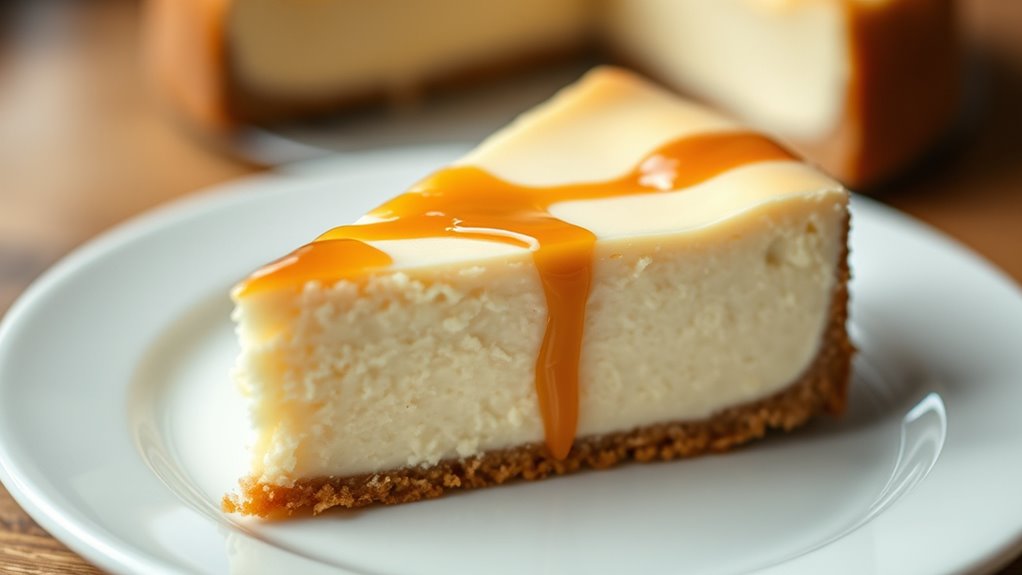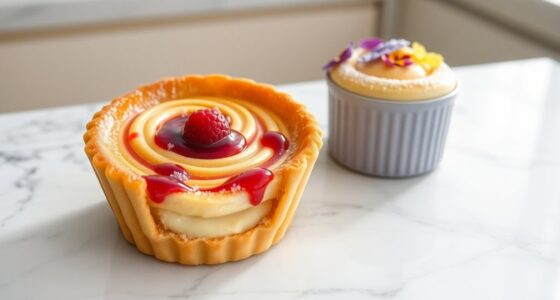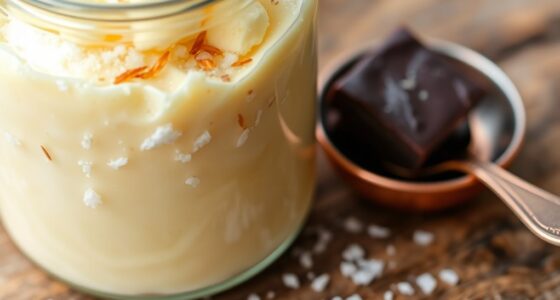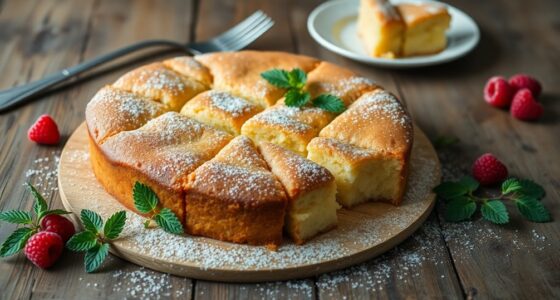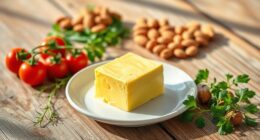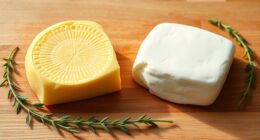To make a cultured-butter cheesecake that’s tartier, creamier, and better, you should start with high-quality fermented butter to add depth and tang. Incorporate fresh dairy ingredients like cream cheese and sour cream to enhance the creamy texture and balance the acidity. Proper techniques, like baking with a water bath and gradual chilling, guarantee a smooth finish. Keep exploring these tips, and you’ll discover how to create a truly exceptional dessert.
Key Takeaways
- Using high-quality cultured butter enhances the cheesecake’s tartness and depth of flavor through natural fermentation.
- Incorporating cultured butter in the filling creates a creamier, more luscious texture compared to traditional versions.
- Balancing acidity with ingredients like sour cream or lemon juice boosts tartness and overall flavor complexity.
- Proper baking techniques, including a water bath and gradual chilling, ensure a smooth, silky, and less cracked cheesecake.
- Garnishing with fresh fruits and fruit coulis elevates flavor brightness and visual appeal, making it taste tartar, creamier, and better.
Understanding Cultured Butter and Its Unique Flavor Profile
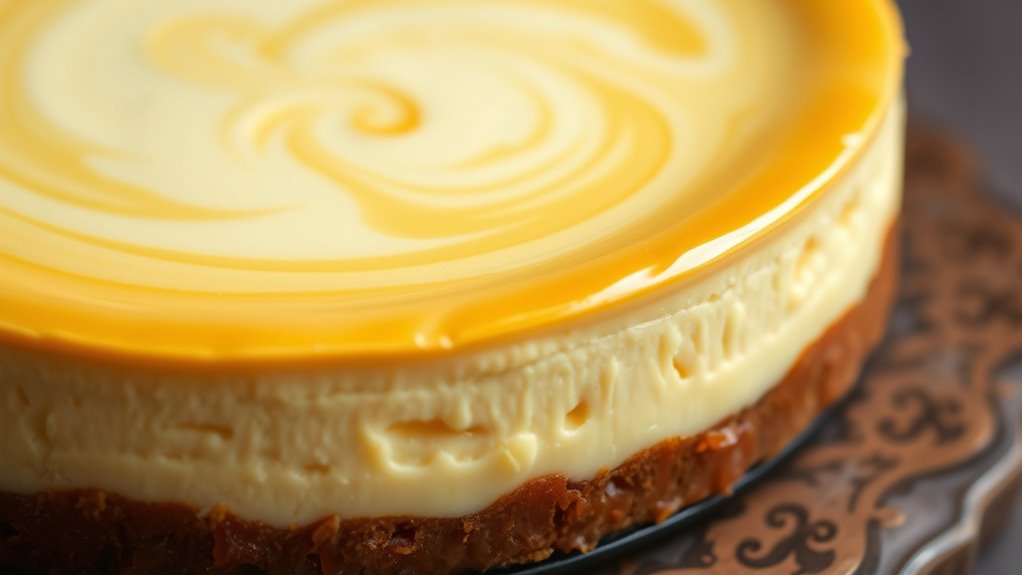
Cultured butter stands out from regular butter because it’s made through fermentation, which develops its complex and tangy flavor. During cultured butter production, beneficial bacteria are introduced to cream, allowing fermentation to occur before churning. This process amplifies flavor development, resulting in a richer, more nuanced taste compared to standard butter. The fermentation not only enhances the tangy notes but also deepens the buttery aroma and adds a subtle complexity. As you explore cultured butter, you’ll notice its distinctive tang and depth, making it a favorite for baking and finishing dishes. Its unique flavor profile stems directly from the fermentation process, which transforms simple cream into a sophisticated ingredient that elevates your cheesecake and other baked goods. Additionally, using vetted equipment can ensure optimal fermentation conditions and consistent flavor quality.
Choosing the Right Ingredients for a Perfect Cultured-Butter Cheesecake
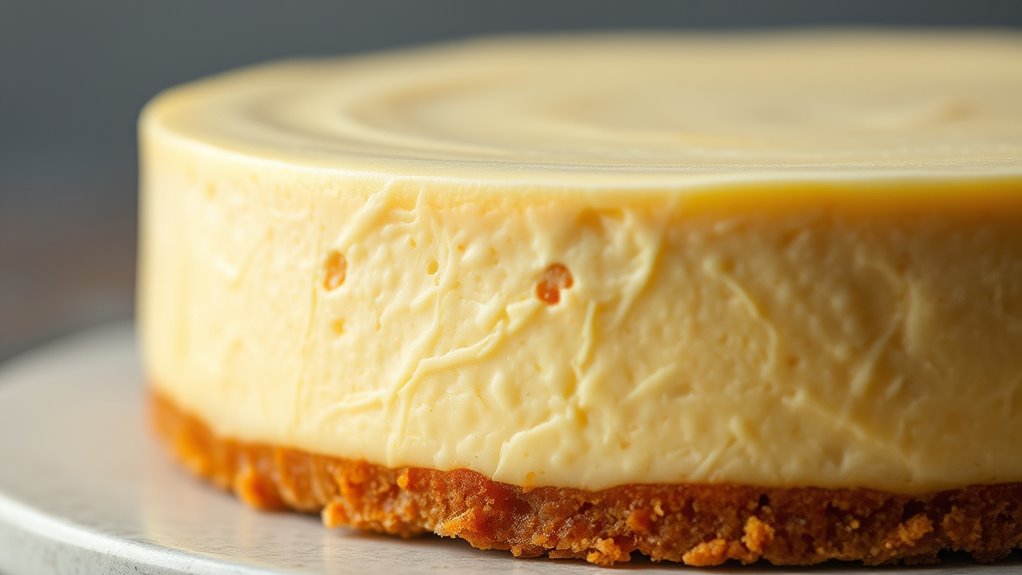
To achieve a perfectly balanced and flavorful cultured-butter cheesecake, selecting high-quality ingredients is essential. Focus on butter fermentation, as it directly influences the depth of flavor and tartness. Opt for cultured butter with a rich, complex profile, which enhances the cheesecake’s creaminess and tartness. The fermentation process develops natural acids and tang, contributing to flavor enhancement. Use fresh, high-quality dairy products to guarantee a smooth texture and vibrant flavor. Avoid cheap or overly processed ingredients, which can dull the cheese’s natural complexity. Additionally, choose ingredients that complement the cultured butter’s tang, such as a good-quality cream cheese and natural sweeteners. Proper ingredient selection ensures a cheesecake that’s tart, creamy, and irresistibly flavorful. Understanding the importance of fermentation can help in selecting ingredients that develop the desired depth of flavor.
Step-by-Step Guide to Making Cultured-Butter Cheesecake Crust
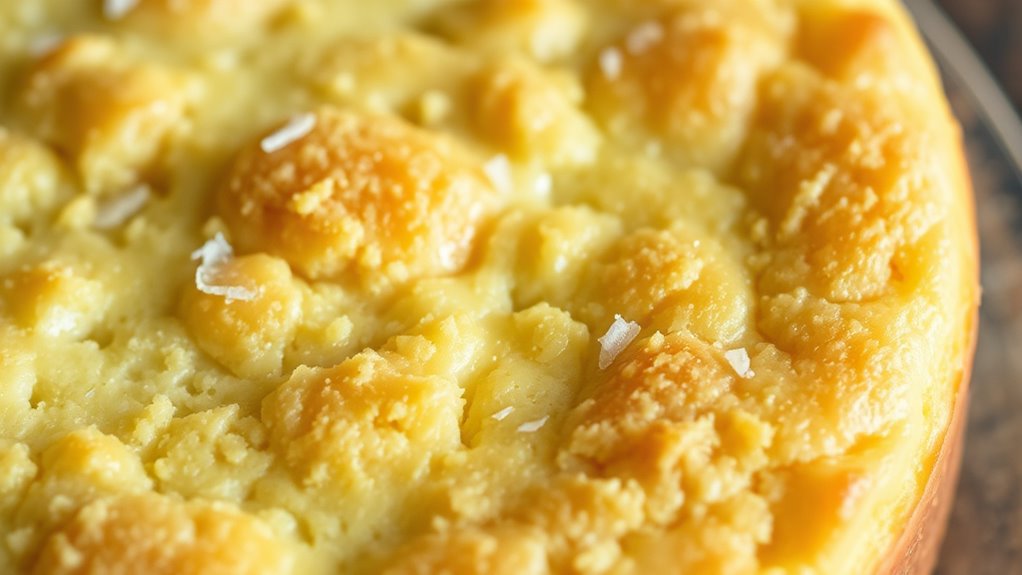
Start by gathering all the ingredients and tools you’ll need to make the crust. Next, prepare the mixture according to the recipe instructions, ensuring everything is well combined. When shaping the crust, consider tuning options to optimize its texture and stability. Finally, bake the crust and let it cool properly before adding the filling.
Gather Ingredients and Tools
Gathering the right ingredients and tools is the essential first step in making a delicious cultured-butter cheesecake crust. Start by selecting quality ingredients like cultured butter, graham crackers or cookies for the base, and a touch of sugar. Having a good mixer or food processor will help you blend everything smoothly. Keep cheese pairings in mind; a mild, creamy cheese complements the crust and makes dessert plating look more appealing. Measure your ingredients precisely to ensure the perfect texture. Gather tools like a mixing bowl, spatula, and a tart pan with a removable bottom. Being well-prepared prevents interruptions and ensures a seamless process. With everything ready, you’ll set a solid foundation for a crust that’s tart, creamy, and better than traditional versions. Incorporating attention and focus during preparation can also improve the quality of your final product.
Prepare the Crust Mixture
Begin by melting the cultured butter until it’s just softened but not greasy. This assures it easily blends with the other crust ingredients. In a mixing bowl, combine crushed graham crackers or your preferred crust base with a touch of sugar and salt for added flavor. For butter substitution options, you can use clarified butter or a neutral oil if desired, but cultured butter enhances the crust flavor with its tangy richness. Pour the melted cultured butter into the dry mixture, stirring until everything is evenly coated and resembles wet sand. The goal is to create a cohesive, crumbly texture that will hold together when pressed into your pan. This step guarantees a flavorful, buttery crust that complements and elevates your cheesecake. Incorporating cultured butter adds a unique tang that enhances the overall flavor profile of your crust.
Bake and Cool Properly
Once your crust mixture is well combined, press it evenly into the bottom of your prepared pan. Preheat your oven to the specified temperature, usually around 350°F (175°C). Bake the crust for about 10-12 minutes, or until it turns golden and fragrant. Keep an eye on it to prevent burning. Once baked, remove the pan from the oven and let the crust cool in the pan for at least 15 minutes. Afterward, transfer it to a wire rack to cool completely, which helps prevent sogginess. Proper cooling is essential for a firm crust that holds up against the filling. Avoid rushing the process; a well-baked and cooled crust guarantees a better texture and flavor in your cultured-butter cheesecake.
Preparing the Creamy Filling With Cultured Butter
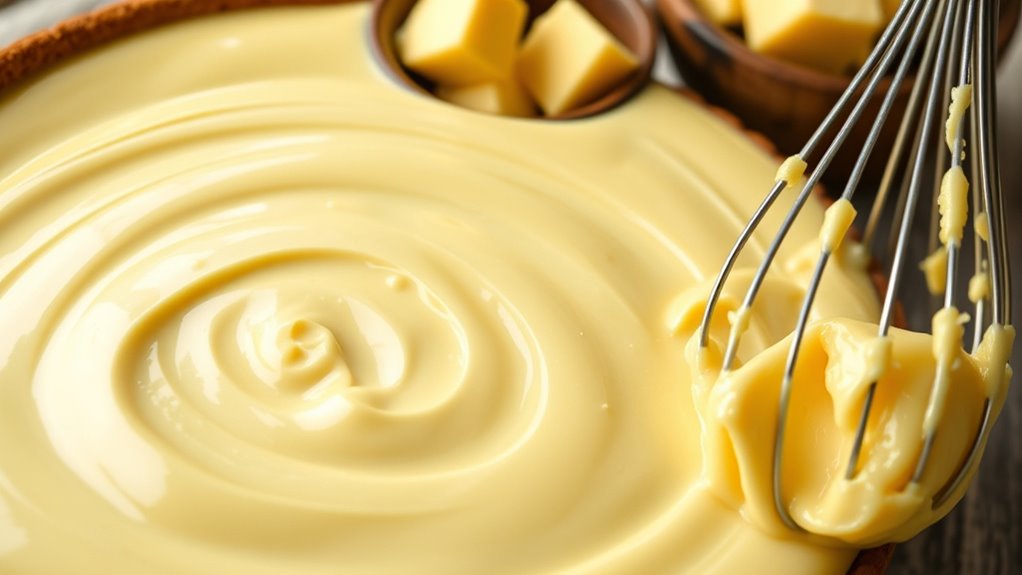
To create a rich, creamy filling for your cultured-butter cheesecake, start by softening the cultured butter to room temperature. This allows for smooth mixing and better incorporation into the filling. Cultured butter fermentation develops a tangy flavor that enhances the cheesecake’s tartness and complexity. To maximize flavor, consider using flavor enhancement techniques like adding a splash of vanilla or a touch of lemon zest. Whisk the softened cultured butter with sugar until light and fluffy, then gradually mix in cream cheese or other ingredients as your recipe calls for. This process guarantees the cultured butter’s fermentation notes infuse the filling, imparting a subtle tang and creamy texture. Proper preparation ensures the best integration of flavors and texture in your cheesecake. Your careful preparation results in a uniquely tart, silky, and flavorful cheesecake.
Tips for Achieving the Ideal Texture and Tartness
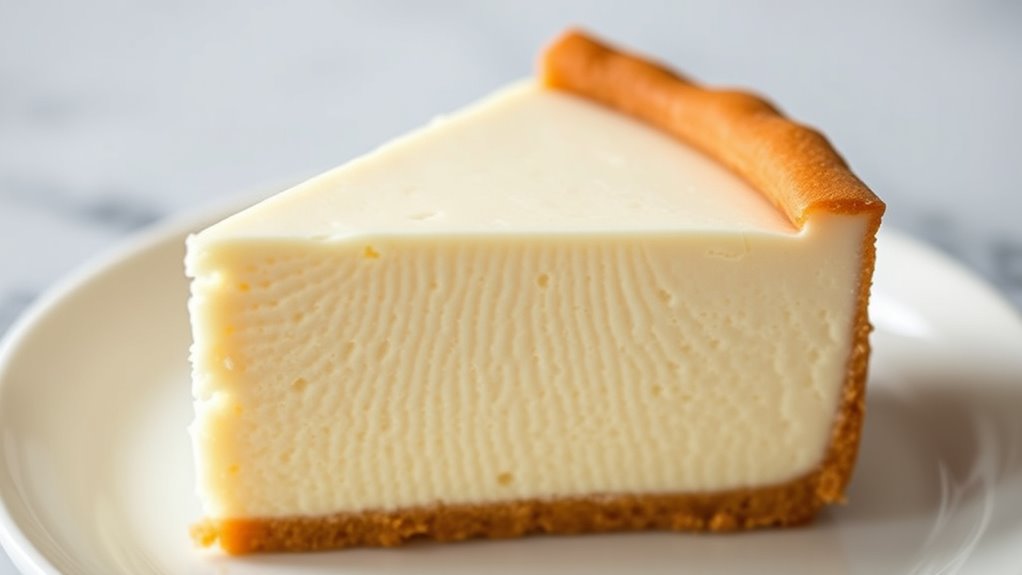
Achieving the perfect texture and tartness in your cultured-butter cheesecake hinges on balancing ingredients and techniques. To enhance texture, incorporate ingredients like sour cream or Greek yogurt, which add creaminess and stability. Be cautious with mixing times; overmixing can lead to a dense or grainy consistency, so blend just until smooth. For tartness balancing, taste your cultured butter before adding it to the filling—adjust acidity with a splash of lemon juice if needed. Using high-quality cultured butter also influences both texture and flavor. Keep in mind that chilling the cheesecake thoroughly after baking helps set the texture and mellow the tartness, resulting in a more balanced, delightful dessert. Additionally, understanding merchant services can help you streamline transactions and manage costs effectively when selling your cheesecake. Focus on these adjustments to achieve a cheesecake that’s perfectly creamy with the right tang.
Baking and Chilling Techniques for a Smooth Finish
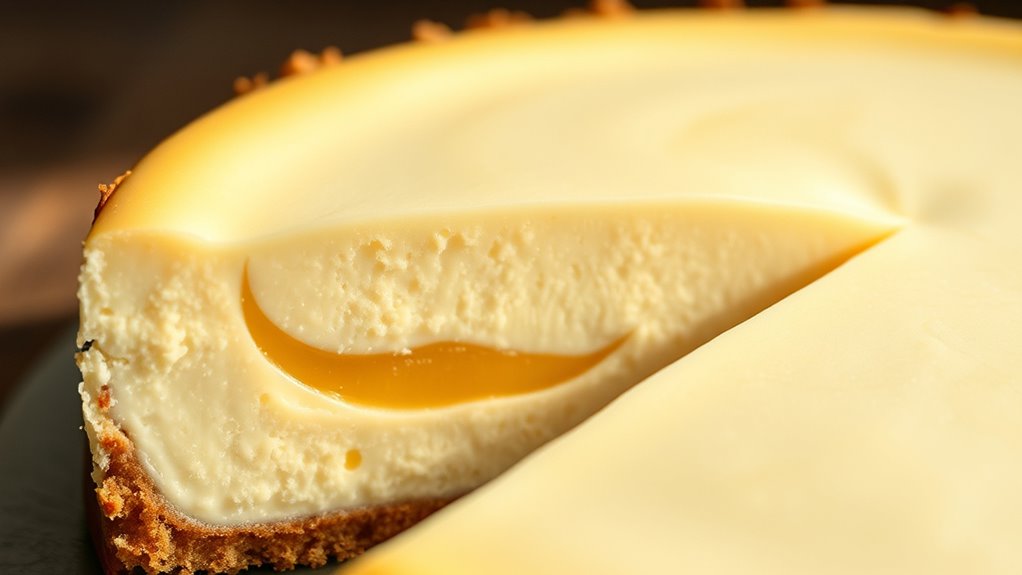
Baking and chilling play crucial roles in guaranteeing your cultured-butter cheesecake has a smooth, professional finish. Proper temperature control during baking prevents cracks and uneven textures, while precise chilling techniques set the filling for a flawless surface. To achieve ideal results, consider these key practices:
- Maintain consistent oven temperature to avoid overbaking or underbaking.
- Use a water bath to regulate heat and minimize cracking.
- Chill the cheesecake gradually, starting at room temperature before moving to the refrigerator.
- Wrap the cake securely to prevent moisture loss and promote even chilling.
- Incorporating automated and precise temperature controls enhances the consistency of baking outcomes.
These steps ensure the cheesecake’s texture remains silky and smooth. Mastering baking and chilling techniques will elevate your dessert, making it irresistibly creamy and visually perfect.
Serving Suggestions and Creative Variations
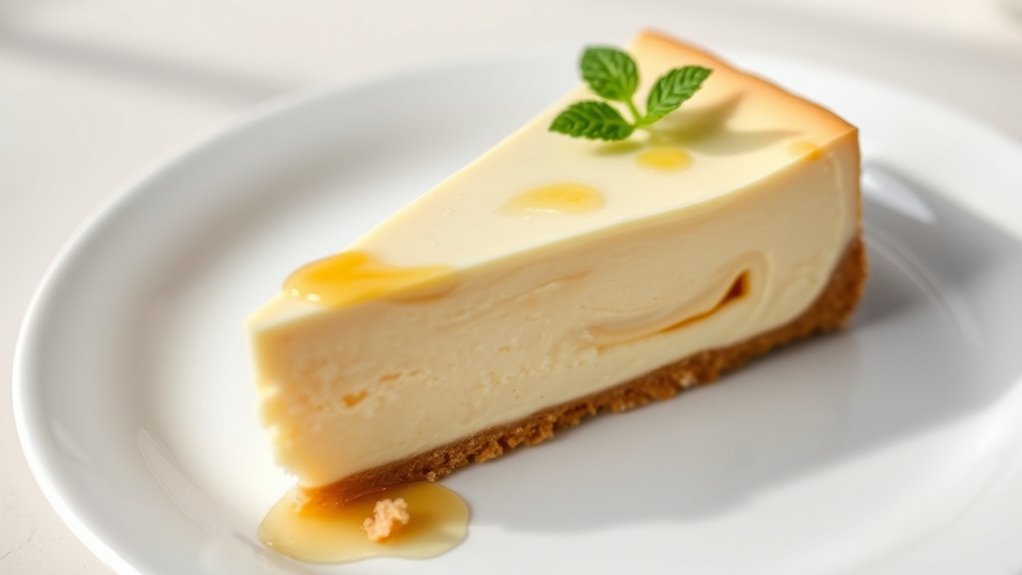
Serving cultured-butter cheesecake offers endless opportunities to customize and elevate its presentation. You can explore various fruit pairings like fresh berries, sliced peaches, or figs to add vibrant color and invigorating flavor contrasts. For a sophisticated look, arrange fruit artfully on top or around the edges of the cheesecake. Consider using drizzles of fruit coulis or compote to enhance visual appeal and taste. Creative presentation ideas include layering thin fruit slices for a striking pattern or topping with whipped cream and edible flowers for an elegant finish. You might also serve individual slices with a dollop of flavored yogurt or mascarpone. Additionally, incorporating regional ingredients can give your cheesecake a unique twist that reflects local flavors. These variations not only make your cheesecake more appealing but also allow you to tailor each serving to suit different occasions and preferences.
Frequently Asked Questions
How Long Does Cultured Butter Cheesecake Typically Last in the Refrigerator?
You’ll want to know the storage duration for cultured butter cheesecake in your fridge. Typically, it stays good for about 3 to 5 days. Keep an eye out for spoilage indicators like sour smell, mold, or a change in texture. If any of these appear, it’s best to discard it. Proper airtight storage will help maintain freshness, but always trust your senses to determine if it’s still safe to enjoy.
Can I Substitute Cultured Butter With Regular Butter in This Recipe?
Imagine baking a cheesecake and wondering about butter substitution. You might try regular butter instead of cultured butter, but note that flavor differences are noticeable—cultured butter adds a tangy richness. In this case, using regular butter will change the taste and creaminess, making it less tart and slightly less complex. While it’ll still turn out, your baked good won’t have that signature cultured butter depth.
What Are Common Mistakes to Avoid When Making Cultured-Butter Cheesecake?
When making cultured-butter cheesecake, avoid common mistakes like overmixing the batter, which can lead to a dense texture. Be sure to use fresh, not expired ingredients, as stale components can affect flavor and consistency. Also, don’t rush the cooling process, and carefully measure your cultured butter to achieve the perfect tartness and creaminess. Paying attention to these details guarantees a cheesecake that’s smooth, flavorful, and truly better.
Is Cultured Butter Cheesecake Suitable for People With Dairy Allergies?
You might think cultured butter cheesecake isn’t for those with dairy allergies, but you can explore dairy free alternatives to make it allergy friendly. While traditional recipes contain dairy, swapping in plant-based butters or cream cheeses can help you enjoy a similar tart, creamy treat. Always check labels and adapt recipes to suit allergy needs, making this dessert more inclusive without sacrificing flavor or texture.
How Can I Adjust the Tartness Level to Suit Different Tastes?
To adjust the tartness level to suit different tastes, you should focus on flavor balancing. If you prefer a milder flavor, increase the sweetness by adding more sugar or honey. For a tangier profile, incorporate a bit more cultured butter or a splash of lemon juice. Tasting as you go helps you achieve the perfect balance, ensuring the cheesecake appeals to everyone’s preferences.
Conclusion
Like Da Vinci’s masterpieces, your cultured-butter cheesecake is a work of art, blending tradition with innovation. Embrace the process, savor the tang, and trust your skills to create something truly memorable. With each bite, you’ll taste the harmony of cultured butter’s depth and your craftsmanship’s finesse. So, go ahead—bring your culinary vision to life and enjoy a dessert that’s as timeless as a great masterpiece.
